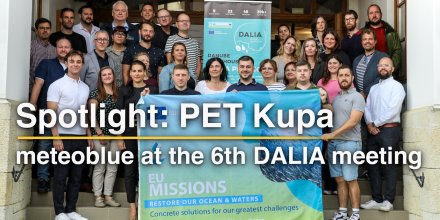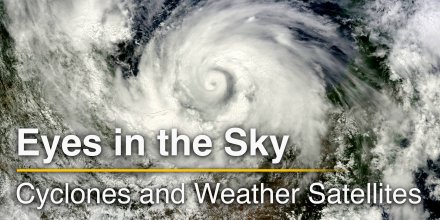
meteoblue на 6-м заседании DALIA: в центре внимания PET Kupa
В рамках консорциума DALIA PET Kupa демонстрирует, как инициативы, от регат по сбору отходов до просвещения населения, могут оказать долгосрочное влияние на состояние рек Европы.

В рамках консорциума DALIA PET Kupa демонстрирует, как инициативы, от регат по сбору отходов до просвещения населения, могут оказать долгосрочное влияние на состояние рек Европы.

Спутники изменили способ наблюдения за нашей планетой, особенно когда речь идет об экстремальных погодных явлениях. От ураганов и тайфунов до наводнений и лесных пожаров – современные метеорологические спутники могут отслеживать развитие штормов в режиме реального времени и помогать оценивать ущерб после прохождения стихийного бедствия.
|
|
|||||||||
|---|---|---|---|---|---|---|---|---|---|
|
Icon
|

|

|

|

|

|

|

|

|
|
|
Температура (°C)
|
|||||||||
|
Ощущаемая температура (°C)
|
2° |
0° |
1° |
3° |
5° |
3° |
2° |
0° |
|
|
Направление ветра
|
С |
СВ |
СВ |
ВСВ |
В |
ВСВ |
ВСВ |
ВСВ |
|
|
Скорость ветра (km/h)
|
С
2-12
2-12
|
СВ
4-17
4-17
|
СВ
5-23
5-23
|
ВСВ
6-28
6-28
|
В
9-31
9-31
|
ВСВ
10-32
10-32
|
ВСВ
11-34
11-34
|
ВСВ
16-45
16-45
|
|
|
Осадки (мм/3h)
|
-
20%
-
|
-
0%
-
|
-
0%
-
|
-
0%
-
|
-
0%
-
|
-
0%
-
|
-
0%
-
|
-
0%
-
|
|
|
Вероятность осадков
|
20%
|
0%
|
0%
|
0%
|
0%
|
0%
|
0%
|
0%
|
|
|
Почасовые данные об осадках
|
|||||||||
|
rainSPOT
Распределение осадков в пределах 20 км
|
|
Давление: 992 гПа
Часовой пояс: CEST (UTC +02:00h)
Спутниковое изображение в реальном времени совмещает видимый свет днём с инфракрасным излучением ночью. Ночью изображение не тёмное, поскольку инфракрасное излучение позволяет обнаруживать различия температур. К сожалению, низкие облака и туман трудно отличить от температуры поверхности, поэтому ночью они могут быть почти незаметны. Снимки со спутника Meteosat для Европы обновляются в реальном времени каждые 5 минут. Изображения GOES-16/GOES-17 (Северная и Южная Америка) и Himawari (Азия) обновляются каждые 10 минут.
Количество осадков оценивается по данным радаров и спутников. Спутниковые оценки осадков менее точны ночью, чем днём.
© 2025 meteoblue, NOAA Satellites GOES-16 and EUMETSAT. Данные о молниях предоставлены nowcast.
Маркер местоположения установлен на 60.67°С 6.39°В. Оранжевые крестики обозначают молнии. Данные предоставлены nowcast.de (доступно в США, Европе, Австралии). Морось или слабый снегопад могут быть невидимы для радара. Интенсивность осадков обозначена цветом: от бирюзового до красного.

В рамках консорциума DALIA PET Kupa демонстрирует, как инициативы, от регат по сбору отходов до просвещения населения, могут оказать долгосрочное влияние на состояние рек Европы.

Спутники изменили способ наблюдения за нашей планетой, особенно когда речь идет об экстремальных погодных явлениях. От ураганов и тайфунов до наводнений и лесных пожаров – современные метеорологические спутники могут отслеживать развитие штормов в режиме реального времени и помогать оценивать ущерб после прохождения стихийного бедствия.
Реклама необходима для поддержания нашего бесплатного сайта с уникальной детализацией и точностью.
Пожалуйста, добавьте www.meteoblue.com в белый список вашего блокировщика рекламы или рассмотрите возможность приобретения одного из наших продуктов:
Уже есть подписка?
Тогда, пожалуйста, войдите.